Croissants – A La Julia Child
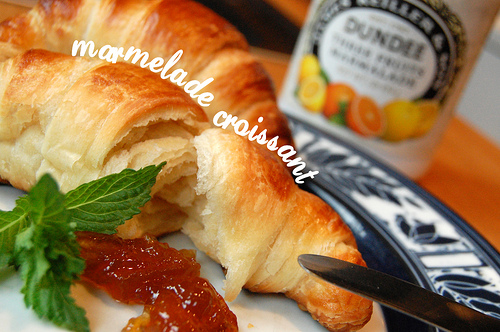
In honor of my culinary hero Julia Child and upcoming movie about her life Julie & Julia (where Meryl Streep plays Julia Child, and Julie Powell is played by Amy Adams) I decided to bake one of her recipes from her TV show The French Chef With Julia Child 2 – Croissants.
Although the process might sound intimidating it is in fact quite simple. Hey – if a rookie like Julia could make it, you can make it too! I will go with you step-by step as presented by Julia in her show. Read along – it is fun and delicious!
Julia Child, More Than A Character
As she goes through her rolling pins collection in the Croissants episode of her late 1960’s TV show The French Chef, where she flamboyantly throws one of them in the trash bin, concluding that “It’s good for nothing, I don’t know why I keep it”, or as she encourages you to take heart when you flip anything in a pan to do it with the “courage of your convictions”, while she spills most of her potatoes on the stove top, Julia Child – the pioneer of cooking shows, gives hope for cooking newbies like you and me who feel so small and intimidated while watching modern big-wig cooking shows where everything turns out perfect, manicured and shiny!
I was extremely excited to hear of the Julie & Julia movie and from what I’ve seen of the trailer, Meryl Streep does an outstanding acting in playing the role of this extraordinary woman! Can’t wait to watch it on 7th of August!
Le Croissant
Considered the donut rival in America (and rightly so), the croissant gained quick popularity in every pastry shop, continental breakfast plate, and even in donut chains. Charles Dickens wrote about the Croissant in his 1872 All Year Round periodical, “the workman’s pain de ménage and the soldier’s pain de munition, to the dainty croissant on the boudoir table“.
But it’s humble origins are mentioned long before that year, when August Zang (an Austrian artillery officer) opened the Boulangerie Viennoise in 1838 in Paris featuring the popular kipfel, that inspired the French pastry chefs to roll out a nationalized version calling it Le Croissant, due to its crescent shape.
Le Recipe
As intimidating (and cliche) as it probably sounds – if you can make a humble omelet, you CAN bake a beautiful batch of 12 Croissants. I mustered up enough courage by watching Julia’s episode on how to make Croissants, and being baking a couple of successful batches since then – well, one of them turned out more browner than needed as I left them in the oven too long [ahem!]. The nice thing about it is that the dough can be prepared ahead of time, and frozen so when you are planning on baking, all you need to do is to get your oven going and your appetite. There are a lot of Croissants recipes, I am sure, but just for the sake of celebrating the movie and the women who inspired it, I’ll stick with her version.
[ad#300×250-green]
Flour Options
Probably the most important step in the recipe is to use the right flour type for this type of pastry. Julia suggests using a low-gluten flour so the dough can be easily rolled without becoming rubbery, etc. You could for instance use a mix of 1 part unbleached all-purpose and 2 parts unbleached pastry flour. She also adds tasteless oil to the mix, to help tenderize the dough.
Yeast Dough
Even if today’s dry yeast has a very small chance of failing to do its job, I will give it a chance to prove itself to be worthy of our croissant dough.
1 Tsp dry yeast
1/4 Tsp salt
1/2 Tb sugar
1/4 cup warm water (not more than 110 degrees, otherwise you’ll kill the yeast)
Start by mixing all these ingredients with the warm water until dissolved, and let it sit for 5 min. If the yeast is active (and it should) it will form a soft foamy mass on its surface:
Croissant Dough
No big secret here to be learned. Make sure that when you measure “1 cup of flour” you actually sweep off the excess with the edge of a knife so you will have a consistent quantity. The quantities given here are good for a batch of 12 croissants. I usually double it and freeze a half of the dough (after I have the butter in it).
2 Cups of your flour mix (see Flour Options above).
1 Tb sugar
3/4 Tsp salt
1/3 to 1/2 cups tepid milk
if using unbleached flour: 2 Tb vegetable oil (I used Canola)
if using bleached flour: 4 Tb vegetable oil
Blend all the above in a mixing bowl (don’t forget the yeast mix) with a spatula into a sticky mass, then out on the board:
Time for some punching – works well when you are mad. Julia suggests the lift-and-throw motion and as she talks and demonstrates the moves, the dough gets stuck to her pastry scraper and goes flying as she exclaims “Whew!” and goes on with her explanation without any trouble… Typical Julia Child! Love it. Un-edited fun!
Keep on being rough with your dough for about 3 minutes – it’ll be somewhat sticky at first but after a good rapid fold and knead with the heels of your hands it will become elastic, smooth and will not stick to your hands anymore:
Time to rise. Plop the dough into a bowl and do a criss-cross scissors snip on its surface to help it rise. Then cover it with a plastic wrap, and let it rise until it becomes double in bulk:
Rising time depends on the room temperature. I found that if I do this in the summer, rising is faster than in winter. About 1 to 1-1/2 hours at say 75 degrees will suffice. Don’t keep it in temperatures higher than 85 degrees or longer that needed (over-rise) since that wll impart an unpleasant taste. At this point you can retard the rising by placing the bowl in the refrigerator:
Then, punch it down into a flat circle, wrap it in wax-paper and chill it for about 20-30 minutes. The chilling is important as it makes working the dough much easier: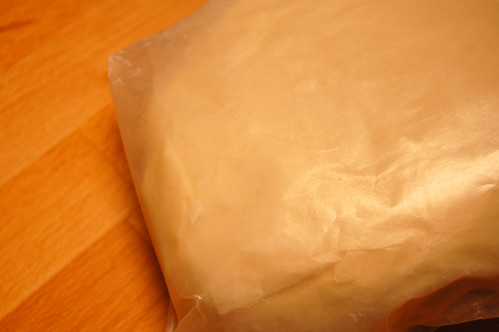
Rolls, Turns and Chills
If the croissant recipe would be considered a somewhat complicated procedure, than this particular step would probably be the one that will need more attention. What makes this basic yeast dough (good for bread, etc.) become a croissant dough is a good old stick of chilled butter. It is butter that makes the world turn. And it is butter that will make the 82 dough layers for our croissants:
Time is now to beat the daylight out of this chilled butter with your rolling pin. The idea here, my friends, is to work the butter into a malleable consistency, free of lumps and very fast, to keep the butter cold – working with melted butter is just not fun: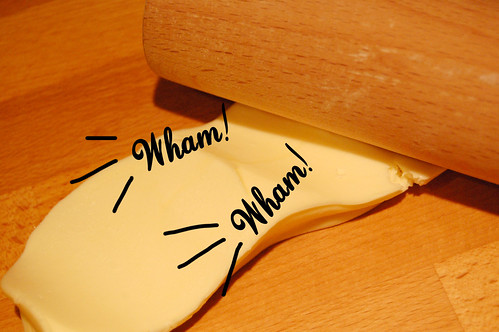
Then finish this procedure by pushing the whacked butter bits by bits out with the heel of your hand, so it is completely lump-free: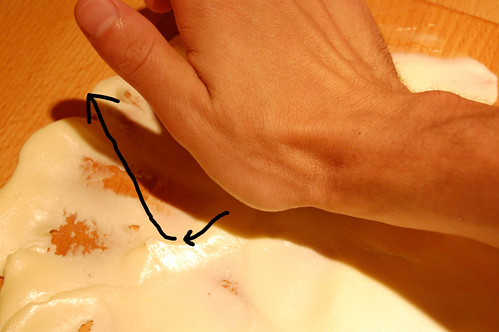
Lovely, huh? Having fun yet? Now, press your dough (I roll it) into an approximate 9″ diameter circle, then form the butter into a 5″ square (square-ish in my case) and place it on the top of your dough (centered):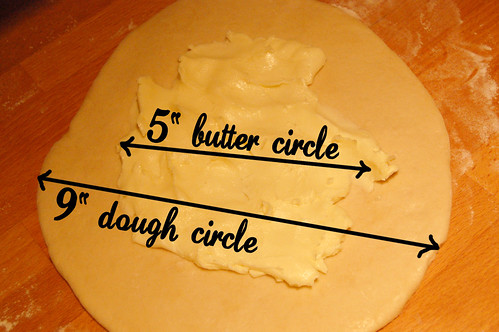
Now gently flip the dough edges (without ripping it!) over the butter and seal in the butter by pinching the dough: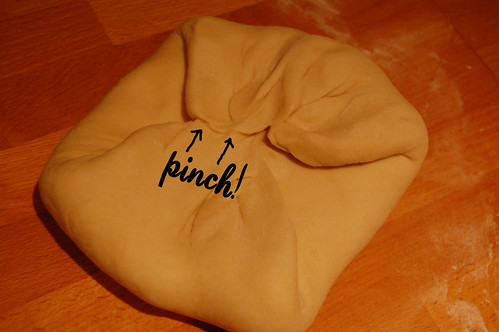
Voila! now you have a nice package of dough with a stick of butter inside, ready to be massaged into many layers. For that, flour your rolling pin and both sides of your dough, place it on your board with the seal side up and start gently rolling back and forth from the center towards the edges to form a rectangle of about 15″ long and 5″ wide. It doesn’t HAVE to be exact, but try to at least get close to that dimension. If there are butter bits that poke through, just pinch the dough over that spot to re-seal it. Also, if the dough became too rubbery (read warm), chill it again for about 20 minutes and continue from where you’ve left it. What you want here is to evenly spread the butter between the two dough layers (this gets you ready for your next step):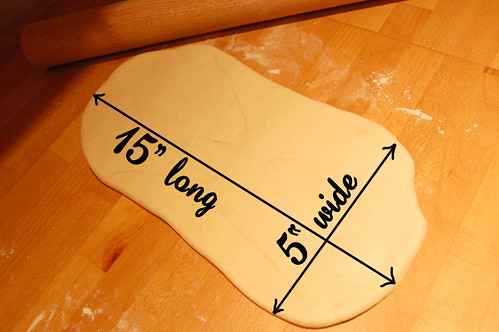
Turns #1 and #2
Okay. What’s a turn in culinary lingo? Julia Child defines it as having the dough folded like a business letter in 3 even layers. And really, that’s exactly what it is. Gently fold the bottom of your rectangle to the center of the dough then fold the top flap over it the same way. That’s defined as turn #1:
Then once again, roll out the dough to the initial 15″ long and 5″ wide rectangle to prepare it for turn #2 just as before. Keep the edges as straight as possible (I re-align them with the rolling pin). You will see that it will look more like a rectangle than before. Rinse and repeat – you got it right?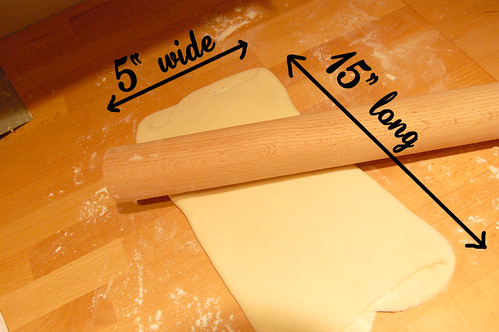
By this time (after turn#2) your dough needs some chilling to be able to roll it another 2 turns. Leave it folded as a business letter, flour it lightly, wrap it in wax-paper and place it in the fridge for about 1-2 hours: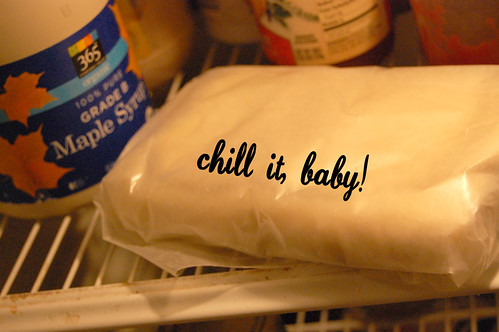
Turns #3 and #4
After the time spent in the fridge (1 to 2 hours) the dough is relaxed and ready for turn #3 and turn #4. Really nothing special here. Just repeat the same process as for the previous two turns – two rollings into the 15″ long and 5″ wide rectangle and two business letter style folding. You will end up with 81 layers of butter between 82 layers of dough. Again, by this time the dough is probably getting to rubbery to work with, so back in the fridge it goes for a 2 hours chill.
Croissants Shaping
After the 2 hour chill, out of the fridge the croissant dough comes and onto a lightly floured board. This time roll it into a 20″ long by 5″ wide rectangle. Try to keep the edges as straight as possible: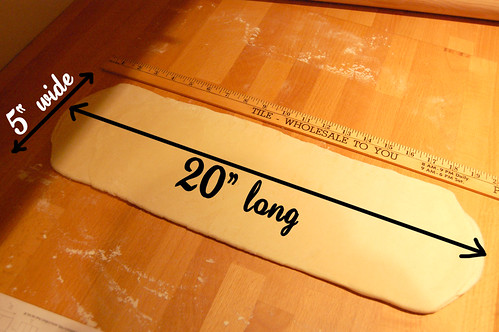
Next, make a middle crosswise cut and chill one half: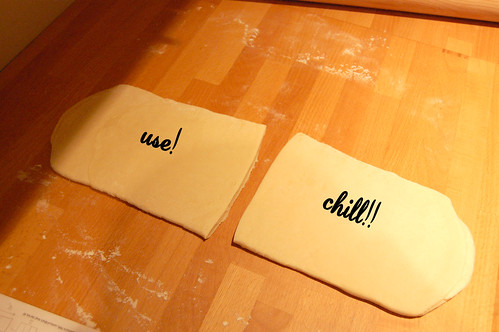
Now, roll the one half of the croissants dough into a 12″ long by 5″ wide rectangle and cut it in thirds and chill two of the thirds:
Now take one of the thirds and roll it into a 5-1/2″ square and cut it on the bias. Mine here doesn’t look terribly square-ish but you get the idea: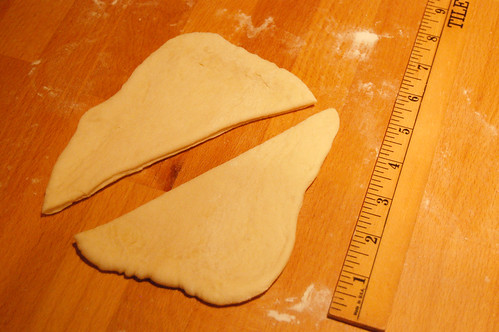
Roll the triangles out to extend to about 7″ long and shape it as much as you can into a isosceles triangle (where two sides are equal in length). Now starting at the base, roll up the dough towards the tip of the triangle, then bend it into a crescent moon form, and place it on a buttered 12″ x 14″ baking sheet (not too close to each other so they don’t fuse together while rising and baking) with the tip of the triangle on the bottom so that it wouldn’t unwrap during baking. Form the rest of the dough the same way into a total of 12 croissants, and let it rest for an hour covered with a plastic wrap. This might be a good time to get your oven going – set it to 475 degrees (mine takes about 45 minutes to heat up). You can freeze the risen croissants for later baking and pop them in the oven while frozen:
Glazing and Baking
Again, no rocket science here. Simple egg-wash. Paint the risen croissants with one egg beater mixed with 1/2 Tsp water:
Then pop them in the pre-heated 475 degree oven and really – keep an eye on them because they bake very fast. Usually something between 10 to 15 minutes depending on how dark brown you want them to look. Don’t do any other activities during this fast bake – you will forgot about the oven like I did so many times. I tend to leave them in until they turn dark-brown. Let them cool on a rack for about 10 minutes and resist the temptation of eating – the are HOT!: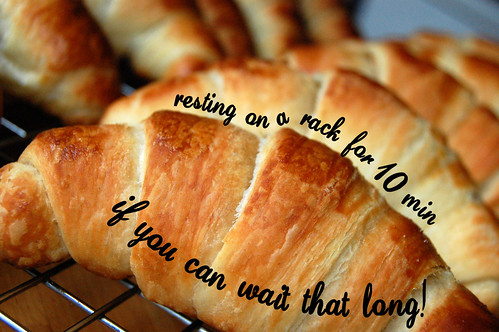
Voila!
Julia mentions in the episode that she could eat Croissants in the morning, for lunch, for dinner, mid-morning or mid-night snack and so on. And I don’t blame her. These evil Croissants are so wicked delicious that can be enjoyed throughout the day. I tend to like them in the morning and for lunch, as a sandwich, or simply with any sort of jam or marmalade. Too bad we don’t have Le Figaro, the French news paper that Julia grabs at the end of the show while sitting down and enjoying her caffé au lait, and freshly baked croissant.

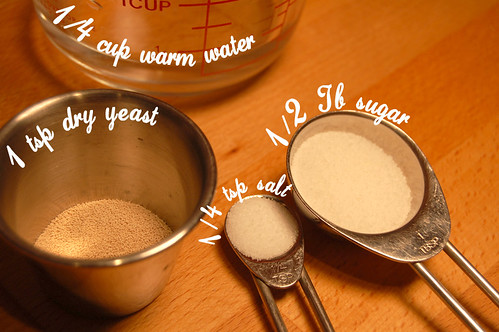
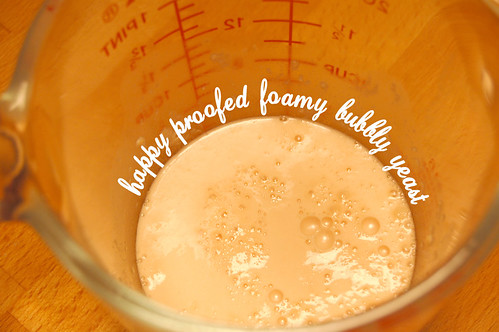
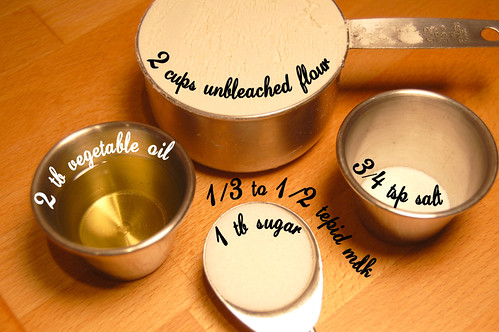
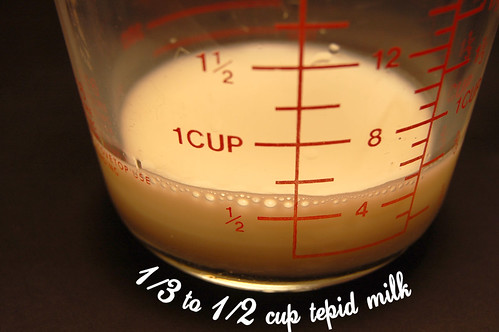
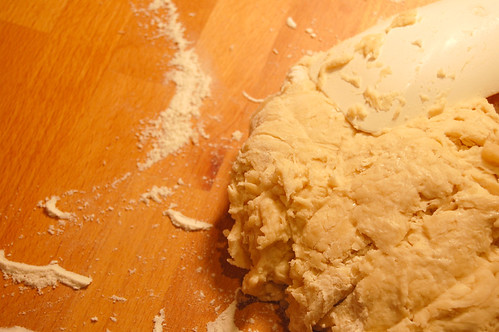
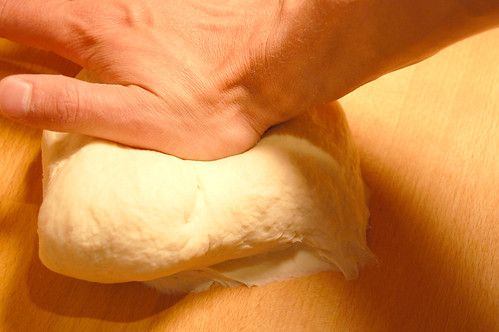
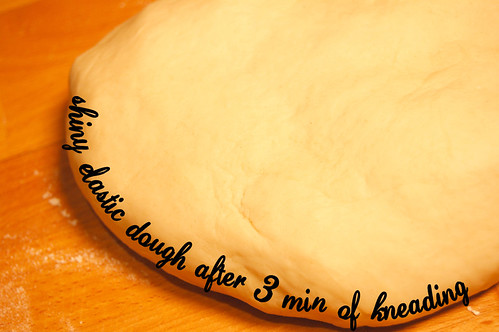
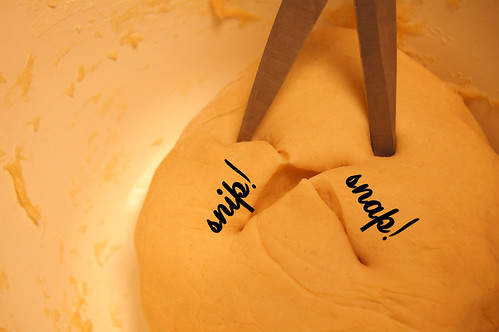

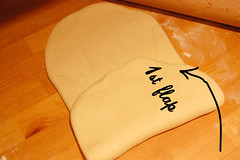
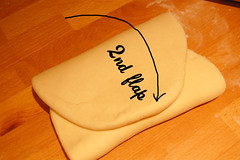

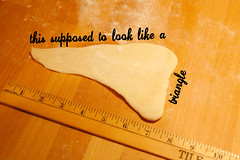
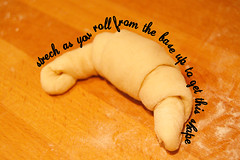
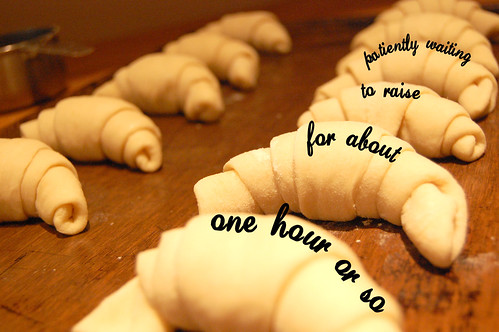
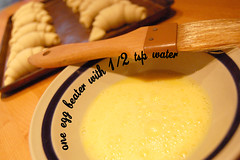
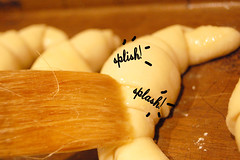
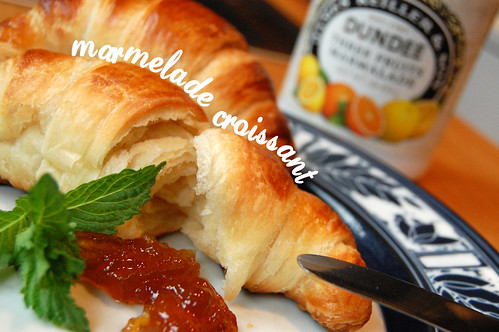



 facebook
facebook instagram
instagram twitter
twitter
Hi!
I came across your post a few days ago, I was fed up of spending £2 a day on croissants! Tried it this afternoon, absolutely brilliant, perfect texture, even if the shape is a bit off :-S Practice makes perfect I suppose!
Thanks for your great post.
Emily
Emily – thanks for the comment! Wow – £2 for a Croissant?!? I can bake a batch of 12 for that price!! Thanks for the feedback!
Hi
Thank you so much for the step by step instructions and the pictures. They were really helpful in taking off the ‘fear’ associated with the long procedure :).
Really great post!
wow! this tutorial is so good and ur croisants are so tempting that it makes me want to join Daring Bakers… just that Im not that daring…
Gabi,
You’re such an inspiration! your instructions are very simple to follow so I may give it a try next weekend…I can’t believe that you posted this recipe 2 years ago and you’re still responding to people’s comments.
My pleasure Rajani! Glad to hear it helped!
Sarah – it’s really an easy recipe after you’ve done it. Try it out – it’s WORTH!
Thanks for the feedback Heba!
Let me know how it turns out. I am actually learning A LOT from people here who are posting so it’s all worth keeping a conversation going…
Hi Gabi, thanks for taking the time to compile this wonderful recipe. I like the fun way in which you present your pictures, makes me more inclined to try it.
I had a question though – I don’t live in the US and I can only get butter in multiples of 100g (while 1 stick is close to 115g). I was thinking of doubling this recipe and using 200g butter for it. Have you ever tried using different ratios of butter, and if so how has the end result been affected by it? I ask because in the multitude of croissant recipes on the internet, the butter content has been the most variable factor, with some recipes asking up to 1 lb of butter for 1 lb of dough!
Also, if I were to chill the dough in the fridge overnight, should I do it before or after making the folds?
Thanks for the tutorial!
I tried this recipe yesterday and they came out semi-successful. They baked up nicely, but like some had commented, the bottom was burnt, top was perfect, and inside was slightly doughy. I’ll try a lower temperature for a longer time next time and maybe move the rack up a notch.
I have some questions though.
– when kneading the dough, it was always sticky to my hands. Eventually it stopped sticking to the counter but still all over my hands and it did not look as smooth as yours did. Either way I continued on with in and it rolled out fine but I was wondering if I was doing something wrong.
– all the turns rolled out nicely but at the very last step where we roll it out to cut (before shaping) my dough kept shrinking. It shrank to the point where the first 2 I tried to shape were completely deformed. The triangle became a stick. Because of this, I increased the sizes of the croissants. Your recipe calls for 12 croissants, but I ended up with 8. Where did I go wrong? Did I roll out the turns improperly making them so elasticy?
Thanks in advance for any tips you may offer!
Mmm, i watched Julie & Julia the other day and was inspired to try a few of Child’s recipes- this is my first one. It’s taken me all day but my lovely looking croissants are finally in the oven!
I can’t wait to try them. Thanks so much for this easy and fun recipe!
Ps. Just ate them with jam and cream- super delicious, might add a bit more sugar next time though 🙂 THANKS
Thank you for this amazing post! I’m trying my hands at croissants for the first time today, and your beautiful step-by-step instructions made the whole process a lot easier. One question, though: how do you turn the dough triangles into such cute, fat crescents? I followed all of the measuring and shaping directions, and my rising croissants look, well, terrible! They’re long and thin. I know it’s my first attempt, but any tips?
Hi Rhianna – Thanks for the comment. I believe I make them smaller. More like a triangle that’s 4″ at the base (from where you actually start rolling), and about 5″ long (if you measure from the base to the tip of the triangle). I also would suspect that there’s something to do with the rising time. The croissants should come out fluffy-flaky-insanely plump.
Thanks Hana! I like moderate sweetness – but sure why not! You can try more sugar. Shouldn’t hurt.
Hi Lynn – Definitely move the sheet up higher so you prevent burned bottoms. It will help to have a pizza stone in your oven on which to place the cookie sheet – this way you’ll have some heat buffer.
With the sticky dough – yes that should be fine. The more you knead it, the more the gluten mesh develops and the dough will become less sticky. Be violent with it.
Yes – you will have to battle elasticity no matter what. That’s why is so important to chill the dough and work it while is chilled. The more you work it (roll it), the more it will heat up and start shrinking. Try to make up for the triangles dimensions so that you have a 4″ at the base and about a 5″ height from the base to the top. I would shape the triangle into the croissant form immediately after it’s rolled so they won’t shrink. Do a couple of batches and eventually you’ll get to be an expert. Also try the pastry flour next time, that has less gluten content and the dough won’t be so elastic.
Hi Pawan – I didn’t tried using other butter ratios but I don’t believe having 30 grams less (if you double the recipe) would hurt. The chilling would be before making the folds and in between the folds. Chilling will help you roll the dough – otherwise it would be too stretchy. Let us know how it turns out!
Gabi,
I just want to say thank you! I have tried this recipe twice. Once with bread flour and the other time with pastry flour. It turned out that pastry flour makes the world turn around for my croissant. So. Good. Though my egg wash was too concentrated and resulted in a slightly harder shell, it was still very very good.
Thank you for the instructions with all the pictures. They do help a lot. And you are so sweet for replying to everyone’s comment 🙂
This is a beautifully done recipe/blog. I’ve been cooking French food professionally for 10 years and it is nice to see a recipe so well explained/photographed. Thank you so much for your time and effort!
i love this recipe, made it 4 times already, thank you
Hi Gabi,
Lovely step by step Demonstration and your photos and comments in it made it more lovely.I was searching for croissant recipe and landed in yours. I made mine today ( Preparing from yesterday) and it came out pretty Good :)))) Thanks a lot for a lovely recipe and i’ve also given the link of yours to my friends in my Facebook page( not a recipe one). Once again Thanks a lot and Great Job. Keep Rocking!!!
This is a great recipe description/blog. I have been wanting to make my own croissants for so long, but always been a bit scared, as all the recipes I have read seemed a little complicated, but this makes it so clear and the step by step photos are super handy!! Thankyou!!!
Hi Janie! Thanks for writing! It sure can be a bit intimidating and honestly it sure was for me. But start with the thought in mind that you will make mistakes anyway and that will automatically lower your expectation. But really, if you follow the recipe you will be able to make a great croissant – Let me know if you need help. Cheers!
merci beaucoup! I looked through the Mastering the Art of French Cooking book multiple times looking for a croissant recipe. I kept thinking if I kept looking, it might materialize. 🙂 I find that most American recipes have more sugar in them than the French version and I’d like to move away from the higher sugar. Again, thank you very much!
We had the most wonderful chocolate croissants in the DR 2 weeks ago. I wanted to make some for my college friends and found your recipe. Just bought the ingredients and can’t wait to try it!
Gabi, very nice post. I particularly like they way you wrapped the text around your photos. very clever!
Hello,
The gift that keeps on giving. You have shown us your love for baking and assuring that Julia Child’s legacy lives on.
After reading your step-by-step instructions and the effort you had put on publishing yours – the least I can do, is to thank you.
I will bake mine shortly.
Happy baking!
-Mervi
Absolutely brilliant post, makes the daunting task of making my favorite pastry seem within reach of the mere mortal…thanks for the gift!!! Now wish me luck.
Just a tip from someone who has struggled with this for a long time: don’t use generic flour…you don’t know what you are getting. Find a good, nationally available brand and stick with it. When I switched to King Arthur all-purpose, not only were my croissants better, they were consistently better no matter in what part of the country. I’ve also gone back and forth between using milk vs. water + non-fat dry milk powder (“high heat treated”), and I’ve found that the latter is more consistent, because milk can vary a lot in terms of enzymes depending on how fresh it is. Sure, you can scald it, but it’s hard to control how much moisture you lose during heating and cooling.
Best regards,
Jim
http://m.facebook.com/?_rdr#!/photo.php?fbid=2078712045664&id=1180911822&set=a.1287592628173.44371.1180911822&__user=1180911822
Thanks for sharing the recipe and the step-by-step instructions.
I haven’t read your blog or seen it before, I must say I LOVE this post, so cute! lovely pictures!
This is a great step-by-step recipe!
I tried to follow it step by step however it seemed that the butter was always melting when I rolled out the pastry and it got a bit too elastic. I couldn’t roll it into perfect triangles. Why do you think this was?
I found your beautiful blog yesterday and made this recipie!!!
Thank you a lot love those croissants!! You may see pictures in my blog!
kisses
Gabi!
Thanks so much from the post! This is THE BEST recipe (and THE EASIEST to follow) I found online. Thank you so much for putting a lot of effort to make the recipe less intimidating and easily understood. Cheers!
thanks much Priscilla! it was my pleasure!
Thanks Julia! Did you make the croissants?! How did they turn out?
it might have been too hot in your kitchen. I found that if I do this recipe in the summer, I end up fighting with the dough a little. You don’t need to stick to the traditional shapes of the croissants. You can do all sorts of geometric creations.
thanks Katherine! That’s nice of you!
Corine – thanks for the comments! i read your blog post about them. Sorry to hear of your fail recipe, and the loss of your mixer. But I don’t think necessarily that was a fail! If you keep doing it you will actually excell at! Do you like your new kitchen aid?!
Jim – thanks much for these precious tips! Yes – I observed that different types of flour do different dough textures. Lately I’ve been using all purpose King Arthur’s and I have to say that indeed makes the best croissants so far. Have to try the milk vs water+non fat milk powder. Or just maybe skim milk?
thanks Obed! Did you try it yet? Good luck!
thanks Mervi! one of the nicest comment I received! Let me know how it turns out!
HI, I’m super excited to try this recipe out! I’m wonder though.. if I was to freeze after the croissants have risen you said to just pop them in the oven frozen to bake. At what temperature and for how long would I do that for. Thank you for any help you can send my way. 🙂
Hi, Me again.. When you double the recipe and freeze half the dough after the butter is in. When your ready to make the croissants with the frozen dough what are the steps on how to make them when you take them out of the freezer? Thank you once for your help. 🙂
thanks for this recipe of croissants!
every time the son of my employer bring us a croissants… my employer really love it but he said that its not the real taste of croissants he tasted during the visit at Italy… so i decided to look the recipe..
at this time… im baking it… i hope it will turn good…
i’ll message again later… with the comments of my employer…
thanks again
Sounds good Beth! Let us know how it turns out!!
Hi Elizabeth – use the same temp (475 F) as for not frozen croissants baking. Take them out when they are GBD (Gold Brown & Delicious).
You can continue the process (after the dough is thawed) from the “Croissants Shaping” onwards. hope it helps!
i baked 4pcs, but while waiting for my employer to get up … i already eat 3 pcs.. because it was really really marvelous… i was ashamed with the one piece left so decided to bake again 4 pcs..
my employer woke up by the time it was ready and prepared also a cup of coffee for him. he said that …” wow! you got the real french croissants”
every week im goin to make croissants!
thanks a lot for sharing this recipe..
GOD BLESS!
These were by far the easiest instructions I could find for making croissants. Tried them, loved them! I’m usually really bad at baking things great the first time, but your post helped a lot! Its been almost 2 years since I made a batch and they are still being spoken of. I’m making another batch this weekend, and wanted to stop by and say ‘Thank You’! Great Pics. Keep ’em coming!